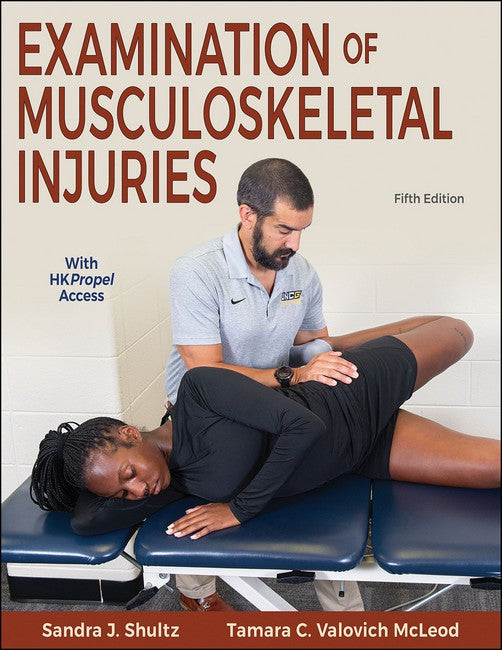Description
Part I. Principles of Examination Chapter 1. Anatomical Nomenclature and Injury Classifications Anatomical Reference Terminology Physical Maturity Classifications Injury Classifications Closed (Unexposed) Wounds Open (Exposed) Wounds Summary Chapter 2. Principles of Examination: An Overview Proper Use of Terminology Examination Components Documenting the Examination Summary Chapter 3. Taking a History General Principles Situation-Specific History and Depth of Inquiry Summary Chapter 4. Observation General Principles Details of Specific Observation Summary Chapter 5. Palpation General Principles Structures to Palpate Palpation Strategies Summary Chapter 6. Active and Passive Joint Motion General Principles Prerequisites for Successful ROM Examination Examination of Physiologic Range of Motion Examination of Accessory Motion Examination of Ligament and Capsule Integrity Summary Chapter 7. Muscle Testing General Principles Manual Muscle Testing Instrumented Muscle Testing Summary Chapter 8. Neurological Status General Principles Region-Specific Neurological Examination Summary Chapter 9. Cardiorespiratory Status General Principles Examination of Cardiorespiratory Status Shock (Cardiovascular Collapse) Summary Chapter 10. Putting It All Together: General Examination Strategies On-Site Examination Acute Examination Clinical Examination Summary Part II. Region-Specific Examination Strategies Chapter 11. Cervical and Upper Thoracic Spine Functional Anatomy Regional Examination Injury Recognition and Special Tests Injury Examination Strategies Summary Chapter 12. Shoulder and Arm Functional Anatomy Regional Examination Injury Recognition and Special Tests Injury Examination Strategies Summary Chapter 13. Elbow and Forearm Functional Anatomy Regional Examination Injury Recognition and Special Tests Injury Examination Strategies Summary Chapter 14. Wrist and Hand Functional Anatomy Regional Examination Injury Recognition and Special Tests Injury Examination Strategies Summary Chapter 15. Lower Thoracic and Lumbar Spine Functional Anatomy Regional Examination Injury Recognition and Special Tests Injury Examination Strategies Summary Chapter 16. Leg, Ankle, and Foot Functional Anatomy Regional Examination Injury Recognition and Special Tests Injury Examination Strategies Summary Chapter 17. Knee and Thigh Functional Anatomy Regional Examination Injury Recognition and Special Tests Injury Examination Strategies Summary Chapter 18. Hip, Pelvis, and Groin Functional Anatomy Regional Examination Injury Recognition and Special Tests Injury Examination Strategies Summary Chapter 19. Head and Face Functional Anatomy Regional Examination Injury Recognition and Special Tests Injury Examination Strategies Summary Chapter 20. Thorax and Abdomen Functional Anatomy Regional Examination Injury Recognition and Special Tests Injury Examination Strategies Summary
Sandra J. Shultz, PhD, ATC, FNAK, FNAP, is a professor and chair in the department of kinesiology at the University of North Carolina at Greensboro, where she serves as codirector of the Applied Neuromechanics Research Laboratory and as director of the Center for Women's Health and Wellness. As a researcher, Shultz focuses on the study of risk factors for anterior cruciate ligament injury in female athletes and has received grant funding from the National Federation of State High School Associations (NFHS), the National Athletic Trainers' Association (NATA) Research and Education Foundation, the National Football League Medical Charities, and the National Institutes of Health. She is the primary author of the NFHS's Sports Medicine Handbook and the NATA's Appropriate Medical Care for Intercollegiate Athletics. She has served as a senior associate editor for the Journal of Athletic Training and currently serves as an editorial board member for Sports Health. Shultz is a certified athletic trainer and member of NATA, where she has a long history of leadership and service. Shultz was inducted into the NATA Hall of Fame in 2015. Her awards from the NATA and NATA Foundation include the Dr. Freddie & Mrs. Hilda Pang Fu New Investigator Award, the Most Distinguished Athletic Trainer Award, the Sayers "Bud" Miller Distinguished Educator Award, and the Medal for Distinguished Athletic Training Research. Shultz is a fellow of the NATA, the American College of Sports Medicine (ACSM), and the National Academy of Kinesiology (NAK). Tamara C. Valovich McLeod, PhD, ATC, FNATA, FNAK, FNAP, is a professor and director of the athletic training department at A.T. Still University in Mesa, Arizona, where she serves as the John P. Wood, D.O., Endowed Chair for Sports Medicine. McLeod was the founding director of the Athletic Training Practice-Based Research Network at A.T. Still University. As a researcher, McLeod has focused on the pediatric athlete with respect to sport-related concussions. She serves as an associate editor of the Journal of Sport Rehabilitation and a senior editor of the Journal of Athletic Training. McLeod is a certified athletic trainer and fellow of the National Athletic Trainers' Association (NATA), where she has a long history of leadership and service. She is a contributing author for the NATA position statements on the management of sport-related concussions and the lead author on the NATA position statement on the prevention of pediatric overuse injuries. In 2016 McLeod was honored by NATA with the Most Distinguished Athletic Trainer Award, and she received the Medal for Distinguished Athletic Training Research from the NATA Foundation in 2023. McLeod is heavily involved in professional service with the Arizona Interscholastic Association; the NFL Head, Neck, and Spine Committee; and the Brain Injury Association of Arizona. In 2019, she received the National Achievement Award for Athletic Training from the Pediatric Research in Sports Medicine (PRiSM) Society.

